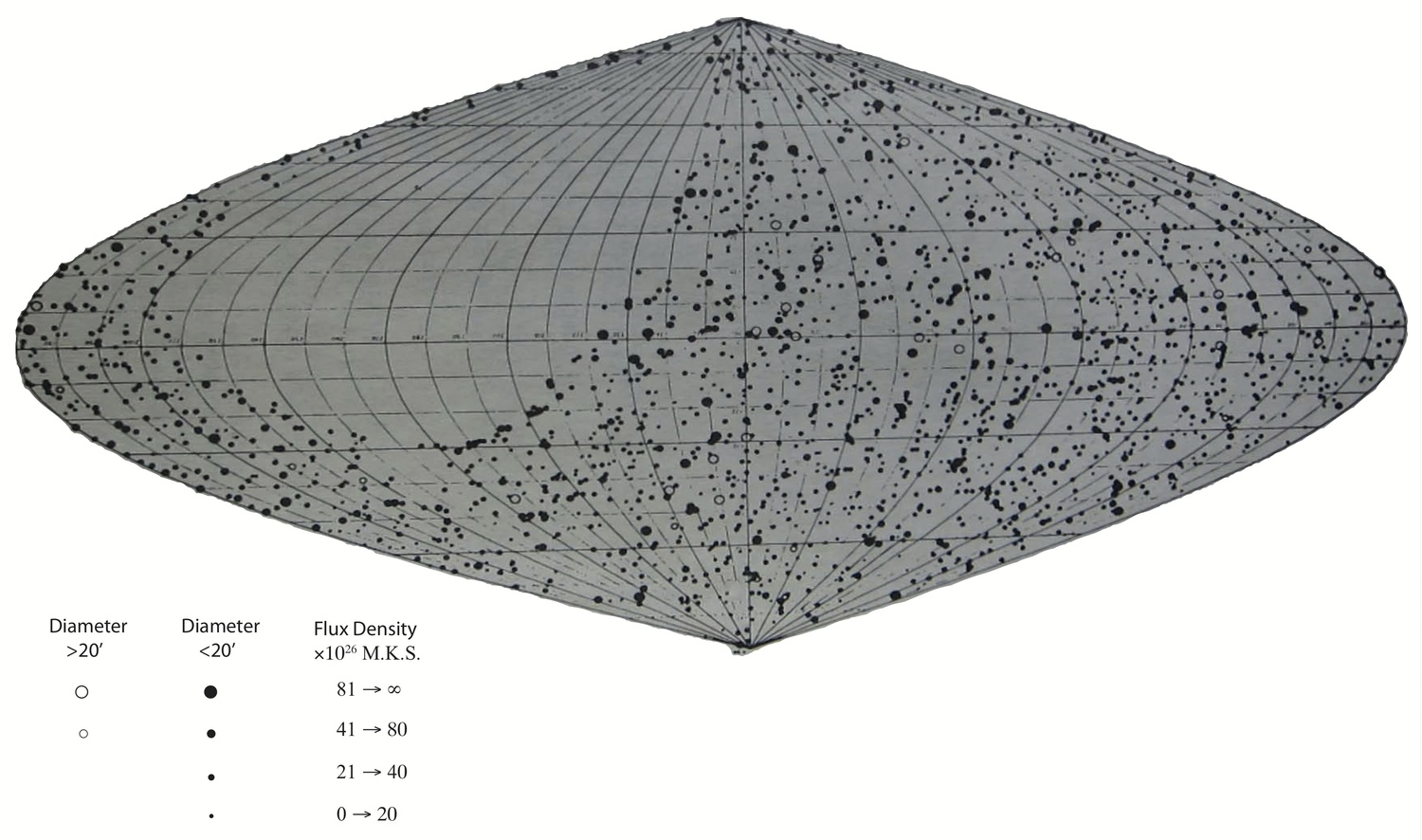12.1 Introduction
A discussion of a number of cosmological problems was presented including radio and optical astronomy as important observational tests of cosmological theory. The point of view adopted was that, while locally discovered laws of physics may possibly suffice to describe observations on the large scale, it is conceivable that
this may not be true on the very large scale requiring extreme extrapolation. Cosmological models should therefore be constructed that are simple and can be subjected to observational tests. With respect to the distribution of matter, it is necessary
to discuss not only the geometrical and kinematical aspects but also physical characteristics such as the abundance of the elements, galaxies, and galactic clusters. Models must be capable of allowing for such evolution. We cannot be sure that we
know all the laws of physics required for a real understanding of the situation, and we should consider seriously any model which is simple and presents the greatest variety of experimentally verifiable conclusions.
12.2 Measurements and Observations
The observations which are most easily interpretable as of a cosmological nature with respect to galaxies are the following quantities:
1distance (brightness)
2red shift
3number of galaxies
4distribution of
 and
and
 (on the celestial sphere)
(on the celestial sphere)
5color and other physical characteristics
6mean density of matter in the world
7distribution and abundance of elements
In the above list, 1 to 4 would represent a distribution in phase space. These would be expected to be predicted (as well as the other measurements) by a cosmological model.
12.3 Cosmological Models
• A.: The “Explosion” Model
The present state of the universe is the result of an explosion of a previous dense state of matter at a time of the order Hubble's constant years ago.
• B.: The “Oscillatory” Models
These are similar to the explosion model, and we are supposedly now on an expansion phase of the “oscillation” which should be followed by a “contraction” of the universe to a repetition of the cycle.
• C.: The “Steady State” Model
In this model the observational quantities on the average do not change with time. It eliminates the effects of local evolution on all statistical observations and avoids therefore a great difficulty in testing the model in contrast to other models. All observations on distant masses are past history of those distant masses. On the steady state model the average of such observations is to be the same as for nearby masses. Unless we know how to calculate the changes in distant galaxies with time as a function of a wide range of detailed information, we would not know how to interpret the data. The virtue of the steady state model is that it bypasses this problem and that it could therefore be disproved by the observations as they are all crucial.
12.4 Observational Data
• A.: Distance vs. Red Shift (
 )
)
The best summary has been given by Sandage on the work of Sandage and Humason. According to the Cosmological Principle,
The data is to be summarized by the relations:

|
where
 = speed of light,
= speed of light,
 = Hubble's constant,
= Hubble's constant,
 = distance,
= distance,
 = fractional shift in wave length;
= fractional shift in wave length;

|
defines the present observational magnitude of Hubble's constant;

|
where
 is a quantity to be discovered by the observations.
is a quantity to be discovered by the observations.
The observations to be made during the next few years should give us the required kinematical information. The predictions of the different models in regard to
 are not resolvable by present observations when one compares the red shift vs. bolometric magnitude. It appears that the newly-developed photoelectric image multiplier technique used at Mt. Palomar by Baum should extend the data sufficiently to make possible the resolution between models in regard to the red shift data.
are not resolvable by present observations when one compares the red shift vs. bolometric magnitude. It appears that the newly-developed photoelectric image multiplier technique used at Mt. Palomar by Baum should extend the data sufficiently to make possible the resolution between models in regard to the red shift data.
In regard to the quantity
 , it is to have the following cosmological
significance:
, it is to have the following cosmological
significance:
 |
Type of Universe |
|---|---|
 |
closed spherical universe |
 |
flat |
 |
open (hyperbolic) |
 |
steady state |
• B.: Red Shift and Number of Galaxies
This correlation would be an especially attractive result. However, insufficient data exist because of the laborious effort involved in examining hundreds of spectrograms of distant galaxies to obtain number counts and spectral measurements. It would be helpful to have this information obtained by mechanical means.
• C.: Color vs. Distance (Red Shift)
The absence of color effect as a function of distance (defined by red shift) as now observed by Stebbins and Whitford can be interpreted to mean there is no large space absorption and (at great distances) there are no large evolutionary effects in times of the order of one quarter of Hubble's constant. This would agree with the steady state model.
• D.: Radio Counts of Galactic Number (Number vs. Brightness (distance))
All number counts are subject to a type of error which must be avoided. In a homogeneous system the law of number (
 ) versus intensity (
) versus intensity (
 ) should be
) should be

|
If the error in
 is symmetric and equal at all intensities, it does not affect the gradient of the relationship which is
is symmetric and equal at all intensities, it does not affect the gradient of the relationship which is
 in magnitude but will shift the curve parallel to itself. When the error is greater at small intensities, the effect is to change the gradient and is then very strongly dependent on the extent of the tail of the error distribution (the small number of large errors). The effect is to steepen the gradient, and can be calculated from the radio source data if an independent measure of the error exists.
in magnitude but will shift the curve parallel to itself. When the error is greater at small intensities, the effect is to change the gradient and is then very strongly dependent on the extent of the tail of the error distribution (the small number of large errors). The effect is to steepen the gradient, and can be calculated from the radio source data if an independent measure of the error exists.
The radio counts are not able to produce a cosmological answer at this time except if it were found unambiguously that the gradient was greater than
 or that it was found possible to observe independently the distance of sources rather than just their brightness, for in the case that they follow the
or that it was found possible to observe independently the distance of sources rather than just their brightness, for in the case that they follow the
 law they can be assumed to be too near to have any cosmological significance.
law they can be assumed to be too near to have any cosmological significance.
• E.: Mean Density of Matter in the Universe
Another type of radio observation of cosmological significance is the mean density of matter. This is involved in the relation (according to some cosmological theories)

|
where
 universal gravitational constant,
universal gravitational constant,
 mean density
mean density
 ,
,
 Hubble's constant (as a time).
Hubble's constant (as a time).
The radio observations on neutral hydrogen (21 cm wavelength) in distant galactic clusters indicate appreciable addition of neutral hydrogen so that much of the matter of the universe can no longer be considered luminous. This is to the effect that
 will always tend to increase as methods are found to detect matter. It would be nice to know the amount of matter in intergalactic space. It is presumably largely ionized because the recombination time is about
will always tend to increase as methods are found to detect matter. It would be nice to know the amount of matter in intergalactic space. It is presumably largely ionized because the recombination time is about
 years. (Dust is exceedingly rare.) Enough dust to affect the recombination time would make intergalactic space opaque to visible radiation.
years. (Dust is exceedingly rare.) Enough dust to affect the recombination time would make intergalactic space opaque to visible radiation.
• F.: Origin of the Elements and Abundance
The recent developments (the work of Fowler, Hoyle, Burbidge, and Cameron on element generation in stars) are to be regarded as a great triumph. According to this theory, elements are being generated at present in stars that are seen at present by calculable nuclear processes. The massive stars have a shorter life and scatter themselves. They throw out their matter containing elements up to the Fe-group. This matter is caught in other stars and in turn captures neutrons (because of the larger cross-section) from light element reactions within the stars. In this way a small proportion of heavy elements will be built up. It has been possible to give explanation for some of the details in the nuclear abundance diagram - an extremely complicated picture. A particular triumph within this theoretical picture of element buildup in stars is the prediction by Hoyle of a C
 nuclear energy level (which was verified to exist). A cosmological requirement thus served as a prediction of a nuclear physics experiment.
nuclear energy level (which was verified to exist). A cosmological requirement thus served as a prediction of a nuclear physics experiment.
According to the steady state model, there is no need to imagine a particular state of matter which was different in the past. As the formation of the elements is proceeding continuously, the overwhelming abundance of hydrogen now implies that the bulk of material is young enough not to have undergone these processes. In other models it is necessary to assume also that the material is mainly young, or that it has been in a non-reactive state until recently. To suppose that some process undid the nuclear combinations imagined as having taken place previously is very difficult and requires circumstances so far from those we know that such speculation seems unprofitable.
Discussion
BONDI  is not a purely geometric quantity. The first three values given (page
is not a purely geometric quantity. The first three values given (page
BELINFANTE
BONDI
DICKE observed that one could not see anything beyond that point and raised the question of the significance of number counts without going into red shift.
GOLD
BONDI
GOLD
BONDI
GOLD
DE WITT inquired about what happens to the energy-stress tensor which is not conserved in the steady-state theory.
BONDI
DE WITT asked why protons should be chosen as the entities which are “created out of nothing.” Since they are already complicated structures, why not go all the way and use heavier nucleii - such as Fe - as well? Or is the theory to be considered purely phenomenological?
GOLD
BONDI
GOLD
DE WITT said that the creation of matter required the existence of some unknown dynamical process as a precursor to the creation which forces the production of protons rather than something else.
SCIAMA
BERGMANN
BONDI
BERGMANN
PIRANI
BERGMANN
PIRANI said it could.
GOLD
BERGMANN
SCIAMA
WHEELER
GOLD hydrogen and helium.
hydrogen and helium.
WHEELER
BERGMANN
WHEELER
BONDI
WHEELER
BONDI
ERNST questioned if a steady-state theorist would drop the generalized Cosmological Principle
BONDI
ERNST continued with the statement that this would perforce leave only the stress-tensor and asked where could one go from there.
BONDI
GOLD

Fig. 12.1: Map showing the distribution of radio sources in galactic coordinates. The open circles represent the sources of large angular diameter, and in both cases the sizes indicate the flux density of the sources
